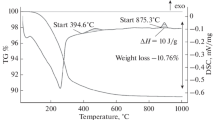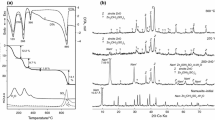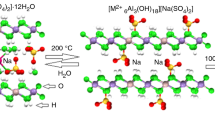Abstract
A comparative thermogravimetric study of the deammoniation of NH4-mordenite, NH4-chabazite, and NH4-stilbite in oxidizing and inert atmosphere has been carried out. The results suggest that in oxygen atmosphere an intracrystalline oxidation of thermally-excited ammonium lattice cations occurs. This reaction proceeds at much lower temperatures than the thermal deammoniation in an inert atmosphere and consequently results in a much better separation of the dehydroxylation process from the deammoniation. Because of the hydrothermal conditions resulting from the formation of water during the oxidizing deammoniation, certain structural changes of the hydrogen form of chabazite and stilbite occur as revealed by changes of the dehydroxylation behaviour.
Résumé
On a effectué une étude thermogravimétrique comparée de la désammoniation de NH4-mordénite, NH4-chabazite et NH4-stilbite, dans des atmosphères oxydantes et inertes. Les résultats permettent de supposer qu'en atmosphère d'oxygène il se produit une oxydation intracristalline des cations du réseau d'ammonium thermiquement excités. Cette réaction s'effectue à des températures bien plus faibles que dans une atmosphère inerte et, par conséquent, conduit à une séparation bien plus distincte du processus de déshydroxylation et de désammoniation. En raison des conditions hydrothermiques qui résultent de la formation d'eau pendant la désammoniation, certains changements de structure de la forme hydrogénée de la chabazite et de la stilbite ont lieu et sont révélés par les changements du comportement de déshydroxylation.
Zusammenfassung
Es wurde eine vergleichende thermogravimetrische Untersuchung der Deammonisierung von NH4-Mordenit, NH4-Chabasit und NH4-Stilbit ausgeführt. Aus dem Verlauf der TG-Kurven kann geschlossen werden, da\ in O2-AtmosphÄre eine intrakristalline Oxydation thermisch angeregter Ammonium-Gitterkationen erfolgt. Diese Reaktion verlÄuft bei wesentlich niedrigeren Temperaturen als die thermische Deammonisierung in inerter AtmosphÄre und führt damit zu einer besseren Trennung von Deammonisierung und Dehydroxylierung. Unter den durch die Bildung von Wasser wÄhrend der oxydativen Deammonisierung gegebenen hydrothermalen Bedingungen gehen — im Falle von Chabasit und Stilbit — gewisse strukturelle VerÄnderungen der H-Form vor sich, die sich in einem unterschiedlichen Dehydroxylierungsverhalten zu erkennen geben.
РЕжУМЕ
пРОВЕДЕНО сРАВНИтЕл НОЕ тЕРМОгРАВИМЕтРИЧЕс кОЕ ИжУЧЕНИЕ РЕАкцИИ ВыДЕлЕНИь АММИАкА В АММОНИИНых сОльх МОРДЕНИтА, шАБА жИтА И стИльБИтА В ОкИслИтЕ льНОИ И ИНЕРтНОИ АтМОсФЕРАх. РЕжУльтА ты пОДтВЕРжДАУт, ЧтО В АтМОсФЕРЕ кИслОРОДА пРОИсхОДИ т ВНУтРИкРИстАллИЧЕ скОЕ ОкИслЕНИЕ тЕРМИЧЕск И ВОжБУжДЕННых АММОН ИИ кАтИОНОВ В РЕшЕткЕ. тАкАь РЕАкцИь пРОтЕкАЕт пР И жНАЧИтЕльНО БОлЕЕ Н ИжкИх тЕМпЕРАтУРАх, ЧЕМ тЕР МИЧЕскОЕ ОтЩЕплЕНИЕ АММИАкА В ИНЕРтНОИ Ат МОсФЕРЕ, И В РЕжУльтАт Е ЧЕгО НАМНОгО лУЧшЕ пОИсхО ДИт РАжДЕлЕНИЕ пРОцЕссА ДЕгИДРОксИ лИРОААНИь От пРОцЕсс А ВыДЕлЕНИь АММИАкА. Иж-жА гИДРОтЕ РМИЧЕскИх УслОВИИ, ВОжНИкАУЩИх ВслЕДстВИИ ОБРАжОВА НИь ВОДы В пРОцЕссЕ ОкИслИтЕль НОгО ВыДЕлЕНИь АММИАкА, пР ОИсхОДьт ОпРЕДЕлЕНН ыЕ стРУктУРНыЕ ИжМЕНЕН Иь ВОДОРОДНых ФОРМ шАБАжИтА И стУльБИтА, ЧтО пОДтВЕРжДАЕтсь И жМЕНЕНИЕМ хАРАктЕРА ДЕгИДРОкс ИлИРОВАНИь.
Similar content being viewed by others
Literatur
P. Chu, J. Catalysis, 43 (1976) 346.
B. I.Shikunov, I. W.Mishin, G. A.Pilojan, A. L.Klyachko-Gupri, L. I.Lafer, B. I.Jakerson und A. M.Rubinstein, Izv. Akad. Nauk SSSR, Ser. Khim. 1973, 767.
T. J. Weeks, D. G. Kimak, R. L. Bujalski andA. P. Bolton, JCS Faraday Trans. I, 72 (1976) 575.
R. M. Barrer, Nature, 164 (1949) 112.
T. J. Weeks, H. F. Hillery andA. P. Bolton, JCS Faraday Trans. I, 71 (1975) 2051.
A. P. Bolton undM. A. Lanewala, J. Catalysis, 18 (1970) 154.
P. B. Venuto, E. L. Wu undJ. Cattanach, Anal. Chem., 38 (1966) 1266.
P. D. Hopkins, J. Catalysis, 12 (1968) 325.
D. W. Breck, Zeolite Molecular Sieves, John Wiley & Sons, New York 1974, S. 446.
P. A. Jacobs, J. B. Uytterhoeven, H. K. Beyer undA. Kiss, JCS Faraday Trans. I, 75 (1979) 883.
I.Belenykaja, H. K.Beyer, A.Kiss und J.Mihályfi, Proceedings of the 2nd Bulgarian-Soviet Conference on Natural Zeolites, Krdschala (Bulgarien), 1979, im Druck.
G. T. Kerr, J. Phys. Chem., 71 (1967) 4155.
P. K. Maher, F. D. Hunter undJ. Scherzer, Advan. Chem. Ser., 101 (1971) 266.
W. J. Mortier, G. S. D. King undL. Sengier, J. Phys. Chem., 83 (1979) 2263.
Author information
Authors and Affiliations
Rights and permissions
About this article
Cite this article
Beyer, H.K., Mihályfi, J., Kiss, A. et al. Oxydative Deammonisierung von NH4-Zeolithen. Journal of Thermal Analysis 20, 351–359 (1981). https://doi.org/10.1007/BF01912884
Received:
Issue Date:
DOI: https://doi.org/10.1007/BF01912884




